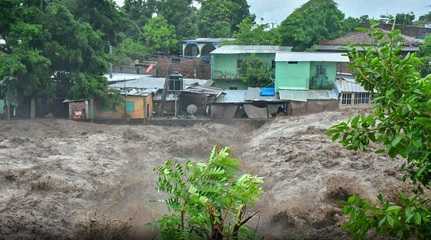
BUSAN, South Korea (AP) — A strong tropical storm slammed into South Korea’s southern coastal regions Thursday, bringing intense rains and winds that toppled trees, ripped off roofs and turned roads into chocolate-colored rivers as it slowly plowed north toward major urban centers near the capital.
There were no immediate reports of storm-related deaths or injuries as of 11 a.m., according to the Ministry of the Interior and Safety. More than 10,000 people, mostly in southern coastal areas, were forced to evacuate from their homes and the number was expected to grow.
Officials shut down hundreds of motorways, streets and public parks and broadcast text alerts warning about the perils posed by the storm, Khanun, which came just weeks after torrential rains caused flash floods and landslides that killed at least 47 people.
More than 30 centimeters (12 inches) of rain has fallen already in southern parts of the mainland and emergency workers were responding to a growing number of floods and landslides as of Thursday afternoon.
After making landfall around 9:30 a.m. near the southeastern port city of Geoje, Khanun headed toward the southeastern inland city of Daegu as of 12:30 p.m., showing slightly diminished strength, with its with maximum winds blowing at 104 kph (64 mph) while moving at 38 kph (23 mph).
Forecasters say Khanun will pound the country with intense rains and winds while slowly plowing through the Korean Peninsula for hours, with its eye brushing the densely populated Seoul metropolitan area where half of South Korea’s 51 million people live. The storm’s strength is expected to be diminished when it moves on to North Korea early Friday, but forecasters said the greater Seoul area would still feel its force until Friday afternoon.
Since Wednesday, the storm dumped nearly 35 centimeters (14 inches) of rain in the southern mainland cities of Changwon and Yangsan.
In Changwon, emergency workers used ropes to rescue pedestrians trapped in huge zones of flooded roads, and responded to landslides that spilled dirt and other debris over motorways. Residents and shop owners blocked their doors with sandbags while workers established flood shields to protect a major seafood market. In Geoje, emergency workers in helmets examined a parking lot where vehicles were smashed or damaged by bricks and other debris apparently flown by forceful winds.
In coastal Busan, South Korea’s second-largest city, winds were blowing at 126 kph (78 mph) and several motorways were closed because of flooding. Emergency workers dressed in orange rain gear cleared uprooted trees that collapsed over roads and responding to destroyed walls and fences, broken windows, and other damage. A low-lying public park in the city’s Yeonje district was entirely submerged in water.
The neighboring cities of Ulsan, Pohang and Gimcheon issued flood warnings for areas near rivers and streams that flow through its urban districts.
More than 350 flights were grounded and nearly 500 motorways were shut. Ferry services were halted while more than 60,000 fishing vessels evacuated to port. Authorities advised schools to take the day off or delay their opening hours, and warned of potential flooding, landslides and huge waves.
Minister of the Interior and Safety Lee Sang-min ordered officials to tightly restrict access to riverside trails, low-lying coastal roads and underpass tunnels, and to swiftly evacuate basement-level homes or houses near mountains in at-risk areas.
“If the storm penetrates the country as forecasters predict, not one region will be safe,” Lee said.
Khanun meandered around southern Japanese islands for more than a week, causing injuries on Okinawa and Kyushu islands, knocking out power and disrupting transit.
Up to 30 centimeters (12 inches) of rainfall is expected in Kyushu and the nearby island of Shikoku through Thursday evening, according to the Japan Meteorological Agency, which warned residents of mudslides, flooding and high winds.




